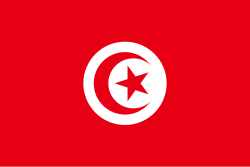Turecká vlajka


 Turecká vlajka
Turecká vlajkaPoměr stran: 2:3
Vlajka Turecka je tvořena červeným listem o poměru stran 2:3 s bílým půlměsícem a bílou pěticípou hvězdou, která se zvenku zhruba dotýká jedním cípem pomyslné spojnice dvou rohů půlměsíce a celý emblém je posunutý od středu kousek k žerdi.[1]
Dnešní podoba turecké vlajky pochází z roku 1844. Oficiálně byla přijata 29. května 1936.[1] Od turecké vlajky byla odvozena tuniská vlajka.
- Vlajka tureckého prezidenta
poměr stran: 2:3 - Tuniská vlajka
poměr stran: 2:3
Rozměry

- G – 1
- A – 1/2 G
- B – 1/4 G
- C – 1/16 G
- D – 2/5 G
- E – 1/3 G
- F – 1/2 G
- L – 1 ½ G
- M – 1/30 G
Historie
Půlměsíc a hvězda jsou staré islámské symboly. Půlměsíc byl na osmanské vlajce již v 16. století a hvězda (dříve osmicípá) od roku 1793.
- Prapory a vlajky Osmanské říše:
- Dynastickou barvou Osmanů byla červená už od středověku
- Z obrazu H. Bosche, zhruba 15.–16. století
- 16.–17. století
- Vlajka z doby panování Selima I. (od roku 1517)
- Vojenský prapor z bitvy u Goroszló (1601)
- Prapor z doby obléhání Vídně (1683)
- Na ilustraci (1721)
- Z obchodní mapy (kolem roku 1780)
- Bowlesovo vyobrazení námořních vlajek (1783)
- Od L. Hochenleittera (1787–1791)
- 1793–1844
- Válečná vlajka balkánských válek a v první světové válce
- 1844–1922
- Ostatní vlajky Osmanské říše
- Sultánova standarta
- Sultánova standarta (námořní)
- Chalífská standarta
- Muslimská obchodní vlajka (1453–1793)
- Židovská obchodní vlajka (1453–1793)
- Tzv. římská (myšleno křesťanská) obchodní vlajka (1453–1793)
- Tzv. latinská (obvykle Albánci) obchodní vlajka (1453–1793)
- Osmanská obchodní vlajka (1793–1923)
Odkazy
Reference
Související články
- Státní znak Turecka
- Turecká hymna
- Dějiny Turecka
- Severokyperská vlajka
Externí odkazy
 Obrázky, zvuky či videa k tématu Turecká vlajka na Wikimedia Commons
Obrázky, zvuky či videa k tématu Turecká vlajka na Wikimedia Commons
Média použitá na této stránce
An Ottoman flag with an eight pointed star rather than the five pointed star which later became typical.
The Ottoman flag and Turkey Republic Flag of 1844–1935. Late Ottoman flag which was made based on the historical documents listed in the Source section. Note that a five-pointed star was rarely used in the crescent-and-star symbol before the 19th century.
Autor: Tijmen Stam (User:IIVQ), Licence: CC BY 2.5
Vexillological symbol according to FIAV / W. Smith
This symbol in particular means that the flag is the current and official flag of the group or nation.
The Muslim merchant flag from 1453 to 1793 in the Ottoman Empire
Autor: BlinxTheKitty, Licence: CC BY-SA 4.0
Possible flag or banner of the Ottoman Empire (or Ottoman army) according to Hieronymus (aka Jérôme) Bosch (crwflags.com), the painter lived in the Middle Ages (c. 1450–1516) in Brabant and some of his paintings show Ottoman flags. These are generally red with a white crescent. It was the end of the XVth century, when the Ottomans had just conquered Constantinople and thus ended the Byzantine Empire, that was a shock for the Christian world.
Autor: Dahn, Licence: CC BY-SA 4.0
Ottoman army flag, featuring the Zulfiqar and captured after the battle of Guruslău (1601); based on the Cserna reproduction.
Ottoman Infantry (Fedais Volunteers) Religious flag
Autor: Χ, Licence: CC BY-SA 4.0
Construction sheet of the Flag of Turkey. Description
Autor: JDKönig, Licence: CC BY-SA 4.0
Flag of the Ottoman Empire in 1783 according to Bowles's Universal Display of the Naval Flags of all Nations (1783).
The Roman (Orthodox Christian) merchant flag from 1453 to 1793 in the Ottoman Empire
The Jewish merchant flag from 1453 to 1793 in the Ottoman Empire
Unofficial Flag of the Ottoman Empire (1517-1793)
Autor: Sette-quattro / Buho07, Licence: CC BY-SA 4.0
Ottoman Imperial Standard at sea, Late 19th and early 20th Century.
Presidential flag of Turkey. The 16 stars represent 16 claimed historical Turkic empires. It was designed in 1922 and adopted in 1925.
Caliphate standard of Abdulmejid II, used from 1922 to 1924.
According to Rıza Nur, sultan Selim I (1512-20) had a white personal flag, while the Ottoman Army flag was red (kızıl bayrak). During Süleyman I's reign (1520-66) the janissaries had a white flag while the timariot cavalry had a red flag. It was used as the Ottoman civic and merchant flag from 1793 to 1923.
Autor: BlinxTheKitty, Licence: CC0
Blue 'Turks' Flag seen from Bowles's Universal Display of the Naval Flags of all Nations https://en.wikipedia.org/wiki/File:Naval_flags_of_the_World_1783_(small).jpg
Autor: Dahn, Licence: CC BY-SA 4.0
Ottoman army banner during the Austro–Turkish War (1788); as depicted by Lucas Hochenleitter.
Depiction of an Ottoman "Zulfikar flag" typically in use during the 16th and 17th centuries.
The design is a rough approximation of the Zulfikar flag used by Selim I in the 1510s, File:Türkei Seidenfahne makffm.jpg
- " During the 16th-17th centuries the Zulfikar flags were widespread in Ottoman army and numerous red Zulfikar flags left in the battles in Europe are shown in museums and one can even see a red, triangular Zulfikar flag in the Doge Palace in Venice." Bariş Kılıçbay, 20 August 1999 (crwflags.com)
Original raster (.png) version uploaded by Ingoman.
Vector (.svg) version created by Kevyn using VectorMagic.com.Autor: Buho07, Licence: CC BY-SA 3.0
Ottoman Imperial Standard, Late 19th and early 20th Century. Each Sultan had his own Tughra.
Autor: Dahn, Licence: CC BY-SA 4.0
Ottoman army banner, as illustrated in the 1721 Hamse (File:Atai (Walters MS 666) - Battle Between the Ottoman and Hungarian Armies.jpg).
Autor: Thespoondragon, Licence: CC BY-SA 4.0
Simplified version of the Ottoman battle standard captured at the Battle of Vienna see File:HGM_Türkische_Standarte_1683.jpg
The Latin (usually Albanian) merchant flag from 1453 to 1793 in the Ottoman Empire















































